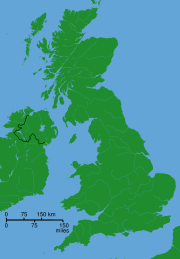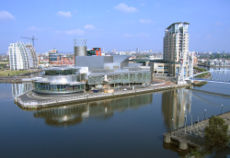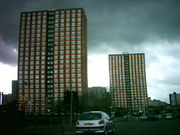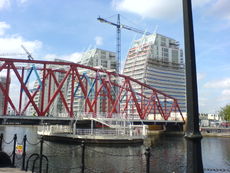Salford
2007 Schools Wikipedia Selection. Related subjects: Geography of Great Britain
| Salford | ||
|---|---|---|
|
|
||
| Statistics | ||
| Population: | 72,750 | |
| Ordnance Survey | ||
| OS grid reference: | SJ805985 | |
| Administration | ||
| Borough: | Salford | |
| Metropolitan county: | Greater Manchester | |
| Region: | North West England | |
| Constituent country: | England | |
| Sovereign state: | United Kingdom | |
| Other | ||
| Ceremonial county: | Greater Manchester | |
| Historic county: | Lancashire | |
| Services | ||
| Police force: | Greater Manchester Police | |
| Fire and rescue: | {{{Fire}}} | |
| Ambulance: | North West | |
| Post office and telephone | ||
| Post town: | SALFORD | |
| Postal district: | M3, M5, M6 | |
| Dialling code: | 0161 | |
| Politics | ||
| UK Parliament: | Salford, Salford and Eccles | |
| European Parliament: | North West England | |
Salford is a city in the north-west of England. With neighbouring towns it forms the borough of the City of Salford in Greater Manchester and is historically part of Lancashire.
The city's eastern boundary separates Salford from the city of Manchester. The centres of the two cities are divided by the River Irwell. The city is part of the Greater Manchester Urban Area.
At the 2001 census, the entire borough (which includes Salford) had a population of 216,103, whilst Salford proper had a population of 72,750.
History
The name of Salford derives from the Anglo-Saxon Sealhford = " sallow-tree ford", in reference to the willow (latin salix) trees that grow alongside the banks of the River Irwell that flows through the city. The city's coat of arms shows three curved blue lines, representing the ford in the river, surrounded by sallow leaves.
Salford gave its name to the ancient hundred of Salford, sometimes called Salfordshire. The settlement's early history was marked by the granting of a charter by Ranulf, Earl of Chester, about 1230. The charter made Salford a free borough. The old medieval centre of Salford was located next to the River Irwell, on the opposite bank to Manchester. Old streets such as Greengate and Gravel Lane formed the market area.
Industrial Revolution
Salford was one of the UK's first major industrial towns and gained status at the start of the industrial revolution. Cloth and silk were made there and the processes of dyeing, fulling and bleaching were carried out. It eventually grew to be one of the greatest cotton towns. Salford was incorporated as a municipal borough in 1844 under the provisions of the Municipal Corporations Act 1835. During the Victorian era new developments, including new municipal buildings appearing along the Crescent, shifted the centre of the town. As Manchester gained importance, Salford's ancient centre became less vital and the area around Greengate and Salford Bridge now shows no sign of its historic importance to the city.
In 1849 the municipal borough was the first in England to establish a public library, museum and art gallery, preceding the Public Libraries Act of 1850. The opening of the Manchester Ship Canal in 1894 and the construction of Salford Docks also brought employment for almost eighty years. The city became a maritime centre with vast docks constructed along the ship canal. From here, locally-produced goods were shipped all over the world. Salford was granted city status by a Royal Charter of 1926. Another charter of 1967 raised the Royal Salford Technical Institute to the status of university by establishing The University of Salford.
Decline
Vast areas of the city were re-developed in the 1960s and 1970s, with the traditional terraced housing giving way to concrete tower blocks and austere architecture. The docks declined during the same period.
Amalgamation
In 1974 the County Borough of the City of Salford (including Pendleton, Claremont, Langworthy, Broughton, Weaste, Ordsall and Seedley) was incorporated into the metropolitan borough of the City of Salford.
The new metropolitan borough also included the former municipal boroughs of Eccles (including Monton, Winton and Barton-upon-Irwell) and Swinton and Pendlebury and the former Urban Districts of Irlam (including Cadishead) and Worsley (including Walkden and Little Hulton).
Regeneration
In the last decade the planning mistakes of the 1960s began to be rectified and the city is beginning to benefit from government investment. However the many high-rise blocks that remain are a striking feature of the city. Salford now has many tourist attractions such as the Imperial War Museum North (located in the neighbouring Trafford MBC area) and the Lowry Centre, an award winning art gallery comprising 2 theatres and 3 galleries. The centre is named after artist L. S. Lowry, many of whose works can be seen there.
Transport
The city is linked to Manchester by the Metrolink tram system, which runs near the docks area to Langworthy and Eccles. There are also railway stations at Salford, Salford Crescent, Swinton, Eccles, Patricroft, Irlam, Walkden and Moorside.
Shopping
Currently, the city's main shopping area is Salford Shopping City, Pendleton — colloquially referred to as 'The Precinct' — close to The University of Salford. However this area suffers from extreme deprivation and is dominated by the central business district of nearby Manchester. There is a shopping precinct at Eccles, with smaller shopping areas at Walkden, Swinton and Little Hulton. Originally, the area around Liverpool Road was a shopping hub, but this has long since declined. Salford Quays has been shortlisted as the new possible city centre by 2020.
Health
The main NHS medical facilities are located at Hope Hospital, near Eccles. The former Salford Royal Hospital was closed in the early 1990s.
The University of Salford was awarded university status in 1967. It is one of four universities in Greater Manchester and has approximately 19,000 students.
Culture
Salford's first annual film festival held at the Red Cinema in the Lowry Outlet at Salford Quays in 2003 was a huge success. The second, in November 2004 achieved similar results, showcasing some new local talent.
Manchester's award-winning international theatre festival 27/4, takes place each July at the North of England's only fringe theatre venue, Studio Salford at the Kings Arms, Bloom Street, Salford, which is also a popular live music venue.
In early 2005, Riga appealed to the EU to advise people against travelling to Salford after a Latvian man was stabbed in the head in Broughton. However, local government insist that Salford is a safe place to visit.
Demographics
Salford is a city of contrasting demographies. Whilst the area immediately adjacent to Manchester City Centre, Salford Quays and suburban areas to the far west of the city such as Worsley are relatively affluent (with the main road colloquially known as 'Millionaire's Row'), other parts of the city are some of the most deprived communities in the UK. In August 2005 a survey by Channel 4 television rated the city as the 9th worst place to live in the UK (based on criteria of crime, education, environment, lifestyle and employment).
The city has seen a major rise in construction especially in the Salford Quays area with modern living spaces and office buildings. It also has regional offices for major corporations including IBM, McDonald's, BUPA and Citifinancial.
Twin towns
 Clermont-Ferrand, a city and commune of France, in the Auvergne région'.
Clermont-Ferrand, a city and commune of France, in the Auvergne région'. Lünen, Germany, http://de.wikipedia.org/wiki/L%C3%BCnen
Lünen, Germany, http://de.wikipedia.org/wiki/L%C3%BCnen
St Ouen France Narbonne France
Famous people from Salford
Born in Salford
- Sir Alex Oppenheim
- Russell Watson
- David Shakeshaft
- Andrew Pollitt
- Bez
- Tim Burgess
- Alistair Cooke ( 1908- 2004)
- Peter Maxwell Davies
- Terry Eagleton
- Sir Harold Evans
- Albert Finney
- Clinton Ford
- Stephen Gallagher
- Walter Greenwood
- Peter Hook
- Graham Gouldman
- Samuel Braham
- Paul Scholes
- John Motson
- Bernard Sumner
- James Prescott Joule
- Mike Leigh
- James Agate
- Elkie Brooks
- John Cooper Clarke
- Robert Powell
- Mark E. Smith
- Shelagh Delaney
- Don Whillans
- Ricky Ashworth
- Christopher Eccleston
- Mark Hendrick
- George Coulouris
- Joanne Whalley
- Phil Bardsley
- Tony Wilson
- Jamie Hill
- Wallied Orabi
Residents (past and present)
- The Dooleys (1970s pop group)
- Nico (during most of the 1980s)
- John Virgo
- Ben Kingsley
- Jimmy Savile
- L S Lowry
- James H Reeve
- Harold Riley
- Ryan Giggs
Sport
Salford is one of the few sizeable cities in the UK not to have a professional football team of its own. The nearest team to Salford is Manchester United F.C. just across the Quays in Trafford whom the majority of Salfordians support. Salford has a strong rugby league history and has the Super League side, Salford City Reds who are the premier sporting team, and the National League 2 side Swinton Lions. Other lesser-known teams include Langworthy Reds and Folly Lane. Since Commonwealth Games 2002 The Quays are a major international triathlon site
Districts of the City of Salford
- Pendleton
- Eccles
- Langworthy
- Kersal
- Worsley
- Walkden
- Irlams o' th' Height
- Little Hulton
- Pendlebury
- Swinton
- Wardley
- Irlam
- Seedley
- Cadishead
- Ordsall
- Monton
- Winton
- Weaste
- Broughton
- Peel Green
- Barton-upon-Irwell




